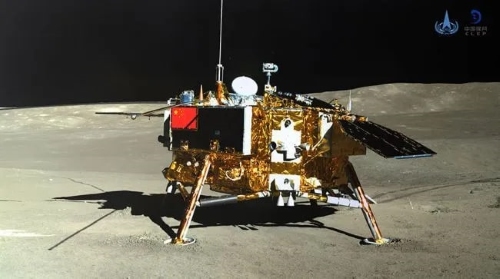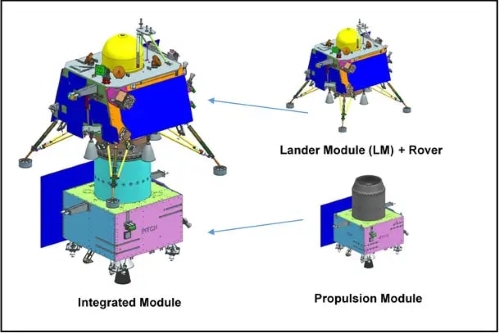China is set to launch its ambitious Chang'e-7 lunar probe in 2026, targeting the lunar south pole to search for water ice and test advanced technologies for future human habitation. This mission aims to explore permanently shadowed craters where water ice is suspected to exist, potentially paving the way for long-term lunar and deep-space exploration.

Source: CNSA
Mission Components
| Component | Function |
| Orbiter | Surveys the Moon from orbit and relays data back to Earth. |
| Lander | Ensures a safe touchdown and deploys scientific instruments. |
| Rover | Explores the lunar surface, collecting data on terrain and resources. |
| Flying Robotic Detector (Hopper) | A mobile explorer that jumps between sunlit and shadowed areas to analyze water presence. |
Why China's Chang'e-7 Mission is Exploring the Moon's South Pole?
The main objective of China's Chang'e-7 Mission to explore the Moon's South Pole is:
| Objective | Details |
| Water Ice Detection | Confirm and analyze the presence of water ice in permanently shadowed regions. |
| Lunar Surface Analysis | Study the topography and geological composition of the Moon’s south pole. |
| Atmospheric Studies | Investigate the thin lunar exosphere for scientific insights. |
| Resource Utilization | Assess the potential for in-situ resource utilization (ISRU). |
| Technological Advancements | Develop and test new technologies for future lunar missions. |
What are the Key Objectives of China's Chang'e-7 Mission?
- Water Ice Detection: Confirm the presence and distribution of water ice in permanently shadowed craters.
- Technology Demonstration: Test innovative landing and navigation systems for lunar exploration.
- Future Lunar Base: Evaluate resource availability to reduce dependency on Earth for water supply.
- Deep-Space Exploration: Support long-term human missions to the Moon, Mars, and beyond.
Why the South Pole?
- Presence of Water Ice: Crucial for sustaining future lunar missions and as a source of hydrogen and oxygen for fuel.
- Continuous Sunlight: Unlike other regions, the South Pole receives long periods of sunlight, ideal for solar power generation.
- Potential for Habitation: The south pole is a prime candidate for future lunar bases.

Source: svs.gsfc.nasa
Which Advanced Technologies Used for China's Chang'e-7 Mission?
Advanced Technologies Used for China's Chang'e-7 Mission is:
- Smart Flying Detector (Hopper): A leg-driven system that absorbs impact, allowing precise landings on uneven terrain.
- Landmark Image Navigation System: China's first deep-space autonomous navigation technology for precision landings.
- Autonomous Terrain Analysis: Enables the probe to assess and adapt to landing surfaces without ground intervention.
- Optimized Solar Panels: Positioned vertically to capture low-angle sunlight at the lunar pole.
What would be the Challenges faced by China's Chang'e-7 during the Mission & what would be its Innovations?
Challenges & its Solutions in details:
| Challenge | Solution |
| Extreme Cold (Below -100°C) | Thermal insulation and energy-efficient systems. |
| Uneven Terrain | Active shock absorption technology in the hopper. |
| Limited Sunlight in Shadowed Craters | Vertical solar panels for enhanced efficiency. |
| Autonomous Operations | AI-driven navigation and terrain assessment. |
What is the Significance of China's Chang'e-7 Mission?
The significance of the Mission would be:
- Reduces Cost and Time: Locating water ice eliminates the need to transport water from Earth.
- Enhances Lunar Capabilities: Demonstrates China's ability to land and operate anywhere on the Moon.
- Prepares for Human Colonization: Supports the establishment of a sustainable lunar base.
- Boosts Deep-Space Exploration: Provides insights for future missions to Mars and beyond.
What is China’s Lunar Ambition for the future?
- Part of China’s long-term roadmap is to establish a permanent lunar research station by the 2030s.
- Collaboration with international space agencies for shared research.
- Potential precursor to manned missions on the Moon.
Which Was the First Country to Reach the Moon's South Pole?
Reaching the Moon’s south pole has been a major challenge due to its harsh terrain and extreme temperature variations. The first country to successfully land a mission on the Moon’s south pole was India, with the Chandrayaan-3 mission.
India’s Chandrayaan-3: The First to Land on the Moon’s South Pole
| Mission Detail | Description |
| Country | India |
| Agency | Indian Space Research Organisation (ISRO) |
| Mission Name | Chandrayaan-3 |
| Landing Date | August 23, 2023 |
| Landing Site | Near the south pole, in the region of 69.36°S latitude |
| Objective | Study the lunar surface, detect water ice, and analyze the Moon’s composition |

Source: isro.gov.in
Why Chandrayaan-3's Landing Was Historic
- First Soft Landing Near the South Pole: Previous missions had only observed the region from orbit.
- Confirmed the Presence of Sulfur and Other Elements: Key to understanding lunar geology.
- Operational Rover (Pragyan): Successfully explored the lunar surface and sent back valuable data.
Comparison with Other Missions
| Country | Mission | Outcome |
| Russia (USSR) | Luna 9 (1966) | First soft landing on the Moon (not near the south pole). |
| USA | Apollo 11 (1969) | First human landing on the Moon (equatorial region). |
| China | Chang’e-4 (2019) | The first mission was to land on the far side of the Moon. |
| India | Chandrayaan-3 (2023) | First successful landing near the South Pole. |
Conclusion
India’s Chandrayaan-3 made history as the first successful mission to land near the Moon’s south pole, showcasing India’s growing space capabilities and significantly contributing to lunar exploration. Building on this momentum, China’s upcoming Chang’e-7 mission marks another major step in space exploration. If successful, it could unlock crucial insights into water ice reserves, paving the way for sustained lunar habitation and further advancing our understanding of this unexplored region of the Moon.
Comments
All Comments (0)
Join the conversation